Heterogeneity of Influencing Factors for Informal Commercial Spaces in Communities from the Perspective of Right to the City: A Case Study of Harbin
Abstract
1. Introduction
2. Framework and Quantification of Influencing Indicators
2.1. Indicator Construction
2.2. Quantification of Indicators
2.2.1. Population Factors
2.2.2. Functional Diversity of Facilities
2.2.3. Accessibility of the Built Environment
2.2.4. Spatial Suitability
2.2.5. Intensity of Community Management
3. Materials and Methods
3.1. Research Framework
3.2. Study Area
3.3. Research Methods
3.3.1. Public Space-Public Life Survey (PSPL)
3.3.2. Spatial Autocorrelation Analysis (Moran’s I)
3.3.3. Multiscale Geographically Weighted Regression (MGWR)
3.3.4. Geographical Detector
3.4. Data Sources
3.4.1. Typology of Informal Commercial Spaces
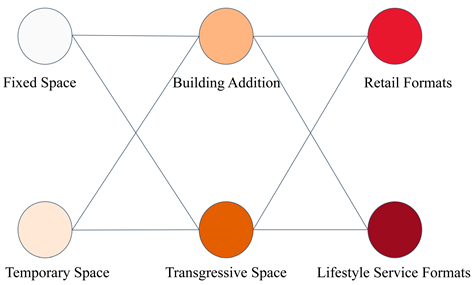
3.4.2. Geospatial Dataset of Informal Economy Locations
3.4.3. Multi-Source Data Acquisition
4. Spatial Distribution Characteristics of Informal Commercial Spaces
4.1. Characteristics of High Concentration and Imbalance
4.1.1. Characteristics of High-Value Concentration
4.1.2. Characteristics of Clustered and Uneven Distribution
4.2. Development of the Multiscale Geographically Weighted Regression (MGWR) Model
4.2.1. Definition and Measurement of the Dependent Variable
4.2.2. Multicollinearity Diagnostics
4.3. Impact of Spatial Heterogeneity in Informal Commercial Spaces
4.3.1. Population Factors
4.3.2. Functional Diversity of Facilities
4.3.3. Accessibility of the Built Environment
4.3.4. Spatial Suitability
4.3.5. Intensity of Community Management
4.4. Results of Factor Interaction Detection
4.5. Differentiated Zoning Governance Based on Spatial Heterogeneity
4.5.1. Zoning-Based Governance
4.5.2. Timing-Based Governance
4.5.3. Categorization-Based Governance
5. Discussion and Conclusions
5.1. Discussion
5.1.1. Theoretical Interpretation of Driving Mechanisms and Deconstruction of Heterogeneous Outcomes
5.1.2. The “Zoning-Timing-Categorization” Framework: Reconstructing the Logic of Informal Commercial Space Governance
5.2. Conclusions
- (1)
- Spatial autocorrelation analysis confirms that informal commercial spaces exhibit significant clustering characteristics (Global Moran’s I = 0.748, p < 0.001). Local Moran’s I further verifies an imbalanced spatial distribution pattern: high-high (HH) clusters (Local Moran’s I: 0.004–2.524; p = 0.002–0.050) are predominantly located within 50 m radii of subway entrances and road intersections—high pedestrian flow nodes—where transgressive temporary retail and service activities concentrate; low-low (LL) clusters (Local Moran’s I: 0.038–5.276; p = 0.002–0.042) are densely distributed in old residential areas with building densities exceeding 65%, dominated by expanded fixed life-service formats. This spatial differentiation pattern fully demonstrates the profound dependence of informal commercial spaces on built environment elements.
- (2)
- Through MGWR modeling and geographical detector analysis, this study reveals the multiscale driving mechanisms and complex interaction effects underlying the formation of informal commercial spaces. The MGWR model identifies three distinct operational scales: the local scale (bandwidth < 13.18%), comprising factors such as weekend pedestrian flow, facility accessibility, and regulatory intensity; the regional scale (bandwidth: 30–50%), encompassing resident population density and the functional diversity of facilities; and the global scale (bandwidth > 70%), involving building density and weekday pedestrian flow. Analysis of driving effects reveals significant spatial heterogeneity in the influences of factors across different socio-spatial contexts. Population density exerts positive effects in old residential areas (β = 0.290) but negative effects in upscale communities (β = −0.546), while weekday pedestrian flow demonstrates consistently positive effects across the study area (β = 0.048–0.087). Particularly noteworthy is the nonlinear relationship observed in community management intensity: unregulated areas show strong inhibitory effects (β = −3.412), whereas moderate regulation promotes commercial clustering (β = 0.955), confirming the “regulation paradox.” Geographical detector results further reveal significant interaction enhancement effects. The interaction between public service facility density and public transportation accessibility exhibits the strongest explanatory power (q = 0.92), indicating that infrastructure synergy substantially amplifies impacts on commercial distribution. The interaction between weekday pedestrian flow and building density (q = 0.78) illustrates the coupling mechanism between built environment fundamentals and passenger flow demand.
- (3)
- This study develops a “zoning-timing-categorization” three-dimensional governance framework that achieves paradigm transformation in informal commerce governance—from “control-compliance” to “strategy-tactic” coordination—through systematic integration of spatial adaptation, temporal coordination, and operational guidance. The framework establishes precise spatial coupling between government strategies and civic tactics by identifying spatial heterogeneity across aging neighborhoods, newly developed communities, and transportation hubs in its zoning dimension; achieves temporal synchronization between urban spatial resources and residents’ daily needs through rhythm-based regulation in its timing dimension; and incorporates diverse informal commercial activities into standardized governance through business access lists and credit management systems in its categorization dimension. The framework’s core breakthrough lies in fundamentally transcending the binary dilemma of conventional “tolerance-eviction-formalization” approaches, establishing an inclusive governance ecology that ensures rights protection and pluralistic co-governance, thereby transforming informal commerce from a governance burden into urban development momentum. Theoretically, it advances the modernization of urban governance models, offering significant reference for Chinese and global cities pursuing people-oriented sustainable governance.
5.3. Research Limitations and Future Prospects
5.3.1. Research Limitations
5.3.2. Future Prospects
Author Contributions
Funding
Institutional Review Board Statement
Informed Consent Statement
Data Availability Statement
Conflicts of Interest
Appendix A
| Evaluation Framework | Variable X | Probability | VIF | Treatment |
|---|---|---|---|---|
| population factors | Resident Population Density | 0.056304 | 1.639970 | Retain |
| Weekday Pedestrian Activity Intensity | 0.000797 * | 2.117299 | Retain | |
| Weekend Pedestrian Activity Intensity | 0.000216 * | 1.510626 | Retain | |
| functional diversity of facilities | Facility Function Mix Index | 0.000000 * | 3.180322 | Retain |
| Facility Function Density | 0.893659 | 1.148985 | Retain | |
| Building Density | 0.838686 | 1.149264 | Retain | |
| accessibility of the built environment | Residential Accessibility | 0.000216 * | 1.974128 | Retain |
| Retail and Commerce Accessibility | 0.472400 | 2.641316 | Retain | |
| Administration Accessibility | 0.000000 * | 1.919509 | Retain | |
| Public Service Accessibility | 0.000000 * | 3.003927 | Retain | |
| Transport Node Accessibility | 0.000000 * | 3.395091 | Retain | |
| Road Intersection Density | 0.002903 * | 1.647737 | Retain | |
| spatial suitability | Proximity to Arterial Roads | 0.000000* | 3.053724 | Retain |
| Proximity to Local Streets | 0.797581 | 4.802300 | Retain | |
| intensity of community management | Absence of Community Management | 0.117155 | 4.633856 | Retain |
| Basic-Level Community Management | 0.000000 * | 6.380415 | Remove | |
| Enhanced Community Management | 0.000002 * | 4.758094 | Retain |
References
- Hart, G.P. Disabling Globalization: Places of Power in Post-Apartheid South Africa; University of California Press: Oakland, CA, USA, 2002. [Google Scholar] [CrossRef]
- Cross, J. Street vendors, and postmodernity: Conflict and compromise in the global economy. Int. J. Sociol. Soc. Policy 2000, 20, 29–51. [Google Scholar] [CrossRef]
- Hu, A.; Zhao, L. The Development Trajectory of Informal Economy in Chinese Cities (1949–2004). J. Tsinghua Univ. Philos. Soc. Sci. 2006, 21, 111–119. [Google Scholar]
- Liu, H. Informal Economy in China; China Statistics Press: Beijing, China, 2011. [Google Scholar]
- Boonjubun, C. Conflicts over streets: The eviction of Bangkok street vendors. Cities 2017, 70, 22–31. [Google Scholar] [CrossRef]
- Peimani, N.; Kamalipour, H. Mapping the Spatiality of Informal Street Vending. J. Urban. Int. Res. Placemaking Urban Sustain. 2025, 18, 329–348. [Google Scholar] [CrossRef]
- Bhowmik, S. Street Vendors in the Global Urban Economy; Taylor & Francis: Abingdon, UK, 2010. [Google Scholar]
- Adama, O. Abuja is not for the poor: Street vending and the politics of public space. Geoforum 2020, 109, 14–23. [Google Scholar] [CrossRef]
- Anaafo, D.; Nutsugbodo, R.Y.; Agyepong, E.; Anane, G.K.; Mensah, B.A.; Bata, P.D. Place making decisions among informal street food vendors in Sunyani, Ghana. Cities 2024, 154, 10. [Google Scholar] [CrossRef]
- Taylor, J.; Song, L. Return to the Streets. Cityscape 2016, 18, 71–88. [Google Scholar]
- Gillespie, T. From quiet to bold encroachment: Contesting dispossession in Accra’s informal sector. Urban Geogr. 2017, 38, 974–992. [Google Scholar] [CrossRef]
- Seomun, G.; Kim, H.; Woosnam, K.M.; Kim, H. Commercial gentrification revisited: Social capital and community governance in regenerated neighborhoods of South Korea. Cities 2024, 149, 104970. [Google Scholar] [CrossRef]
- Lefebvre, H. The Right to the City. Prakt. Teoretyczna 2012, 5, 183–197. [Google Scholar] [CrossRef]
- Harvey, D. The right to the city. Int. J. Urban Reg. Res. 2010, 27, 939–941. [Google Scholar] [CrossRef]
- Soja, E.W. Seeking Spatial Justice in Los Angeles. In My Los Angeles: From Urban Restructuring to Regional Urbanization; University of California Press: Oakland, CA, USA, 2014. [Google Scholar]
- Mitchell, D. The Right to the City: Social Justice and the Fight for Public Space; Guilford Press: New York, NY, USA, 2003. [Google Scholar] [CrossRef]
- Certeau, M.D. The Practice of Everyday Life; University of California Press: Oakland, CA, USA, 2011. [Google Scholar]
- Peng, J.; Peng, X.; Zhang, J. Identifying Key Influencing Factors of Street Vending Economy Integration into Urban Governance—An Empirical Study Based on the DEMATEL Method. Mod. Urban Res. 2021, 8–13. [Google Scholar] [CrossRef]
- Bandauko, E.; Arku, G. “It is no longer the sunshine city, it is now a dump site city”: Discursive construction of urban space and street trading in Harare, Zimbabwe. Cities 2024, 155, 105488. [Google Scholar] [CrossRef]
- Thinh, N.K.; Peimani, N.; Kamalipour, H. Forms and spatiality of street vending in informal settlements: The case of in-between spaces in Hanoi. Cities 2025, 161, 105870. [Google Scholar] [CrossRef]
- Cho, G.H.; Rodriguez, D. Location or design? Associations between neighbourhood location, built environment and walking. Urban Stud. 2015, 52, 1434–1453. [Google Scholar] [CrossRef]
- Zhao, P. The Impact of the Built Environment on Bicycle Commuting: Evidence from Beijing. Urban Stud. 2014, 51, 1019–1037. [Google Scholar] [CrossRef]
- Beckers, P.; Kloosterman, R.C. Business spaces between entrepreneurs and opportunities. The impact of the local built environment and zoning regulations on businesses in Dutch cities. Urban Stud. 2014, 51, 153–169. [Google Scholar] [CrossRef]
- Zhang, Y.; Zhang, L.; Wu, N. The Impact of Urban Built Environment on the Spatial Distribution of Itinerant Vendors—A Discussion on the Planning and Site Selection of Vendors’ Guidance Zones. Hum. Geogr. 2017, 32, 7. [Google Scholar]
- Kim, A.M. The Mixed-Use Sidewalk. J. Am. Plan. Assoc. 2012, 78, 225–238. [Google Scholar] [CrossRef]
- Pang, Y.-Q.; Xue, D.-S.; Wang, D. THE DISTRIBUTION AND SPATIAL IMPACT FACTORS OF STREET HAWKER—A Case Study of Street Hawers on West Zhongshan Road. Hum. Geogr. 2012, 27, 56–61. [Google Scholar]
- Sung, H.; Eom, S. Evaluating transit-oriented new town development: Insights from Seoul and Tokyo. Habitat Int. 2024, 144, 18. [Google Scholar] [CrossRef]
- Wang, H.; Xu, Y.; Wei, X. Rural Resilience Evaluation and Influencing Factor Analysis Based on Geographical Detector Method and Multiscale Geographically Weighted Regression. Land 2023, 12, 1270. [Google Scholar] [CrossRef]
- Xiang, Z.; Sheng, J.; Ban, P.; Li, Q. The Spatiotemporal Characteristics of the Impact of the Built Environment in the Main Urban Area of Wuhan on Street Vitality—Based on Multi-Scale Geographically Weighted Regression. Mod. Urban Res. 2024, 39, 7–16. [Google Scholar]
- Liu, Y.; Liu, X.; Gao, S.; Gong, L.; Kang, C.; Zhi, Y.; Chi, G.; Shi, L. Social Sensing: A New Approach to Understanding Our Socioeconomic Environments. Ann. Am. Assoc. Geogr. 2015, 105, 512–530. [Google Scholar] [CrossRef]
- Ewing, R.; Cervero, R. Travel and the Built Environment. J. Am. Plan. Assoc. 2010, 76, 265–294. [Google Scholar] [CrossRef]
- Hao, X.; Long, Y.; Shi, M.; Wang, P. Beijing Street Vitality: Measurement, Influencing Factors and Planning and Design Implications. Shanghai Urban Plan. 2016, 2016, 9. [Google Scholar] [CrossRef]
- Zhao, C.; Yang, B.; Liu, D. PSPL Survey Method: An Evaluation Method for Urban Public Space and Public Life Quality—A Study on Jan Gehl’s Theory and Method of Urban Public Space Design (3). Chin. Landsc. Archit. 2012, 28, 34–38. [Google Scholar] [CrossRef]
- Zhu, C.; Zheng, L.; Zhang, Y. Analysis of the Spatial Heterogeneity of Shared Bicycles Based on MGWR. Logist. Sci. Technol. 2024, 47, 72–77. [Google Scholar]
- Wang, X.; Hu, J.; Qiu, B. The Impact of Public Service Facilities on Housing Prices from the Perspective of Space-Time Accessibility—A Study Based on Multi-Scale Geographically Weighted Regression (MGWR). Mod. Urban Res. 2024, 39, 116–122. [Google Scholar]
- Shen, T.; Yu, H.; Zhou, L.; Gu, H.; He, H. The Impact Mechanism of Second-Hand Housing Prices in Beijing—A Study Based on the Multi-Scale Geographically Weighted Regression Model (MGWR). Econ. Geogr. 2020, 40, 9. [Google Scholar]
- Fotheringham, A.S.; Yang, W.; Kang, W. Multiscale Geographically Weighted Regression (MGWR). Ann. Am. Assoc. Geogr. 2017, 107, 1247–1265. [Google Scholar] [CrossRef]
- Yang, X.; Zhang, X.; Li, S.; Tian, Y.; Tan, C.; Ding, S.; Kalonji, G.; Xu, L. Increasing urban flooding facing metro system: Evidence from Internet media records in China from 2001 to 2021. Int. J. Disaster Risk Reduct. 2025, 124, 105551. [Google Scholar] [CrossRef]
- Wang, J.F.; Zhang, T.L.; Fu, B.J. A measure of spatial stratified heterogeneity. Ecol. Indic. 2016, 67, 250–256. [Google Scholar] [CrossRef]
- Jacobs, J. The Death and Life of Great American Cities; Vintage Books: Vancouver, WA, USA, 2012. [Google Scholar]
- Kalnins, A.; Praitis Hill, K. The VIF Score. What is it Good For? Absolutely Nothing. Organ. Res. Methods 2025, 28, 58–75. [Google Scholar] [CrossRef]
- Harvey, D. The urban process under capitalism: A framework for analysis. Int. J. Urban Reg. Res. 1978, 2, 101–131. [Google Scholar] [CrossRef]
- Lefebvre, H. The Production of Space; Basil Blackwell: Oxford, UK, 1991; ISBN 978-0-631-18177-4. [Google Scholar]
- David, H. From Managerialism to Entrepreneurialism: The Transformation in Urban Governance in Late Capitalism. Geogr. Ann. Ser. B Hum. Geogr. 1989, 71, 3–17. [Google Scholar] [CrossRef]
- Harvey, D. The Limits to Capital: New and Fully Updated Edition; Basil Blackwell: Oxford, UK, 1982. [Google Scholar]
- Mahabir, R.; Schuchard, R.; Crooks, A.; Croitoru, A.; Stefanidis, A. Crowdsourcing Street View Imagery: A Comparison of Mapillary and OpenStreetCam. Int. J. Geo-Inf. 2020, 9, 341. [Google Scholar] [CrossRef]
- Zhang, F.; Zu, J.; Hu, M.; Zhu, D.; Kang, Y.; Gao, S.; Zhang, Y.; Huang, Z. Uncovering inconspicuous places using social media check-ins and street view images. Comput. Environ. Urban Syst. 2020, 81, 101478. [Google Scholar] [CrossRef]
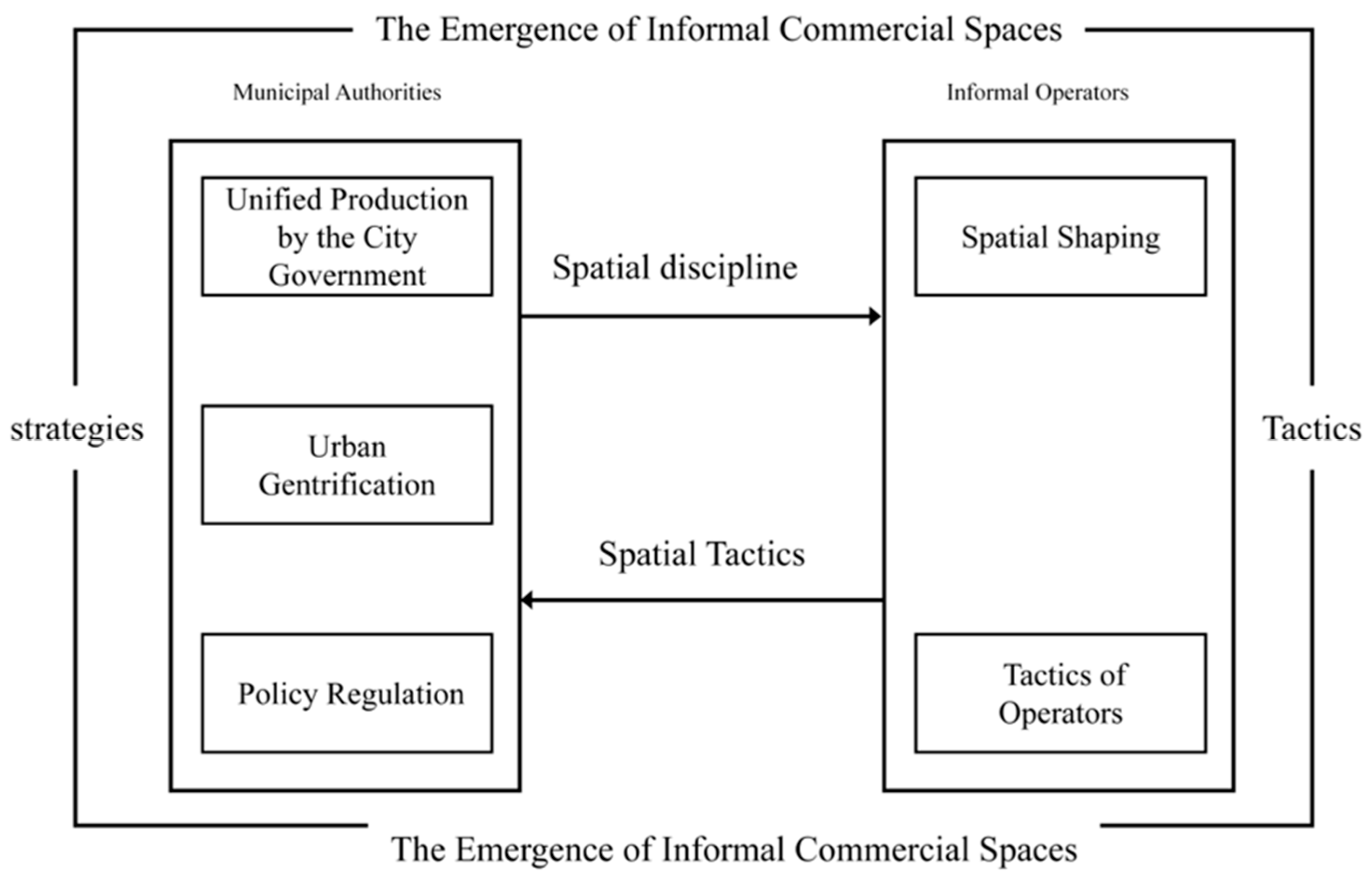
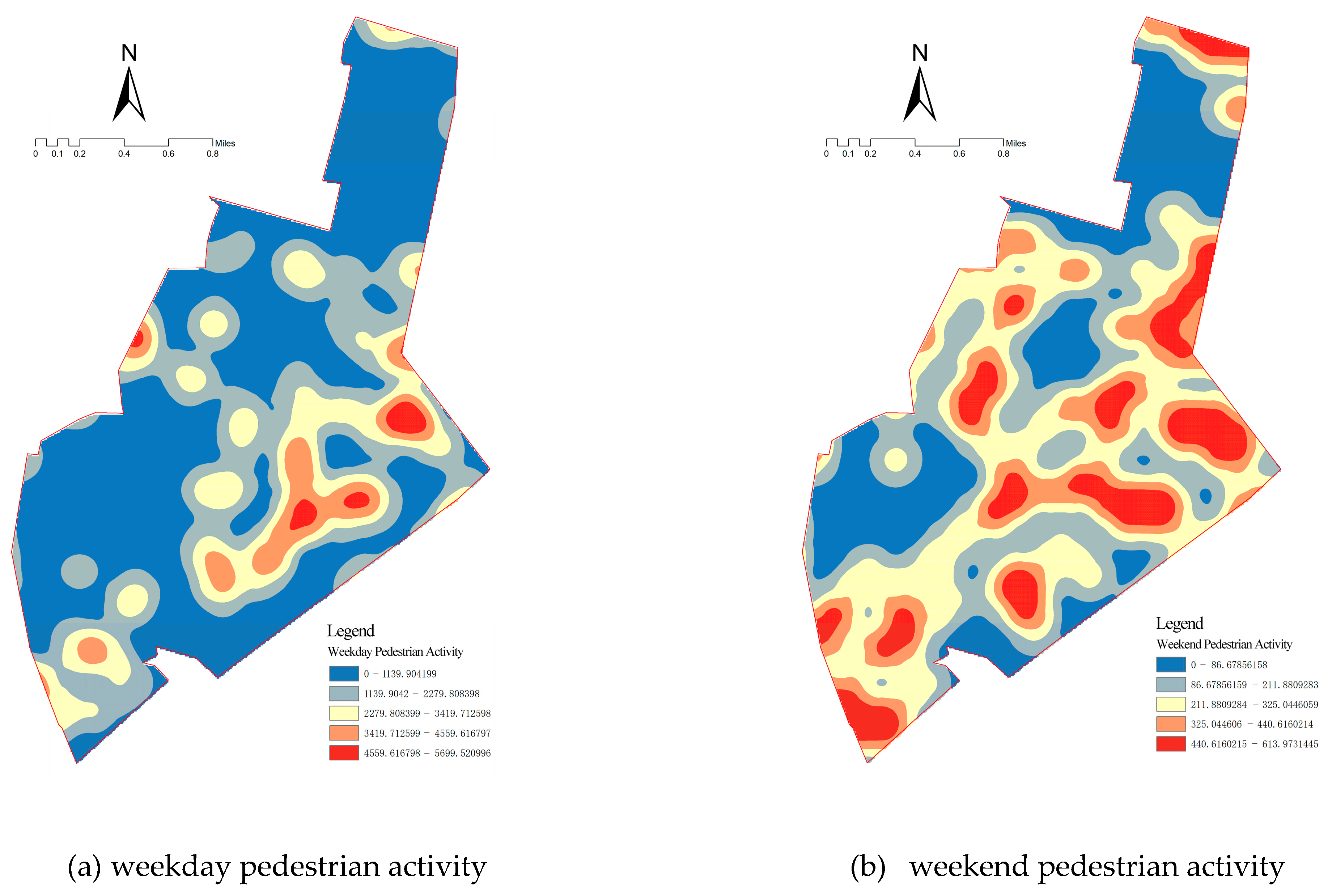
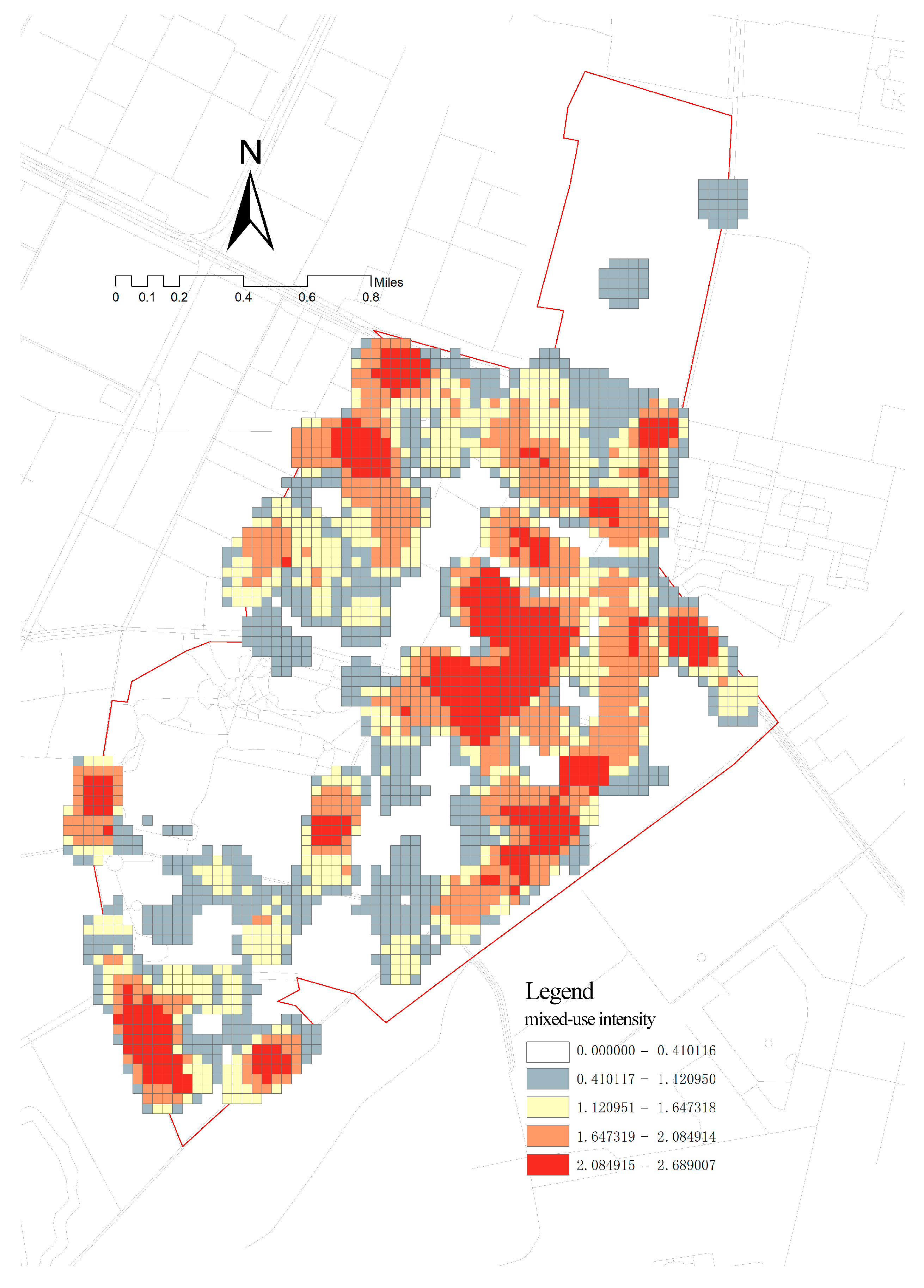
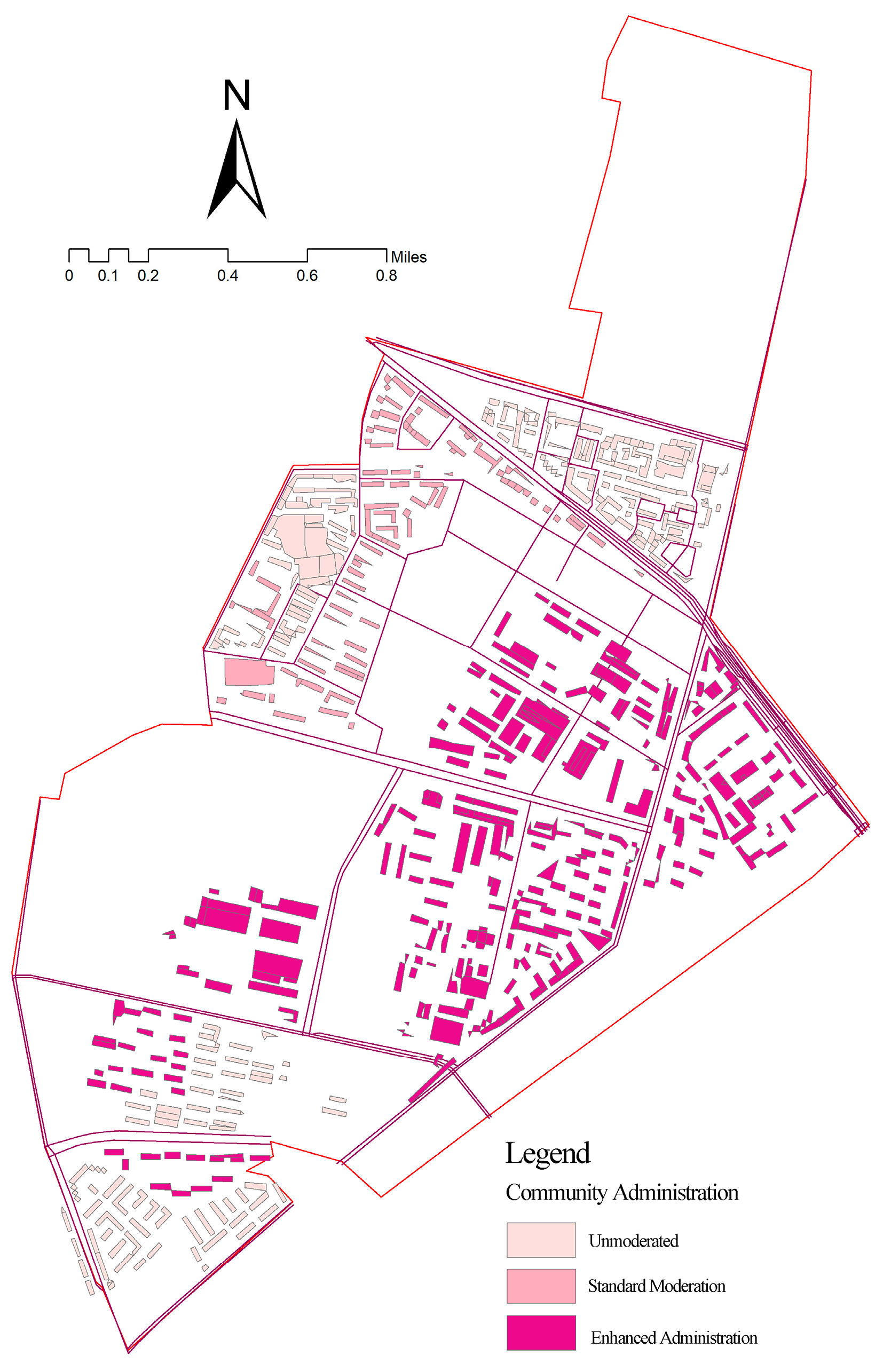
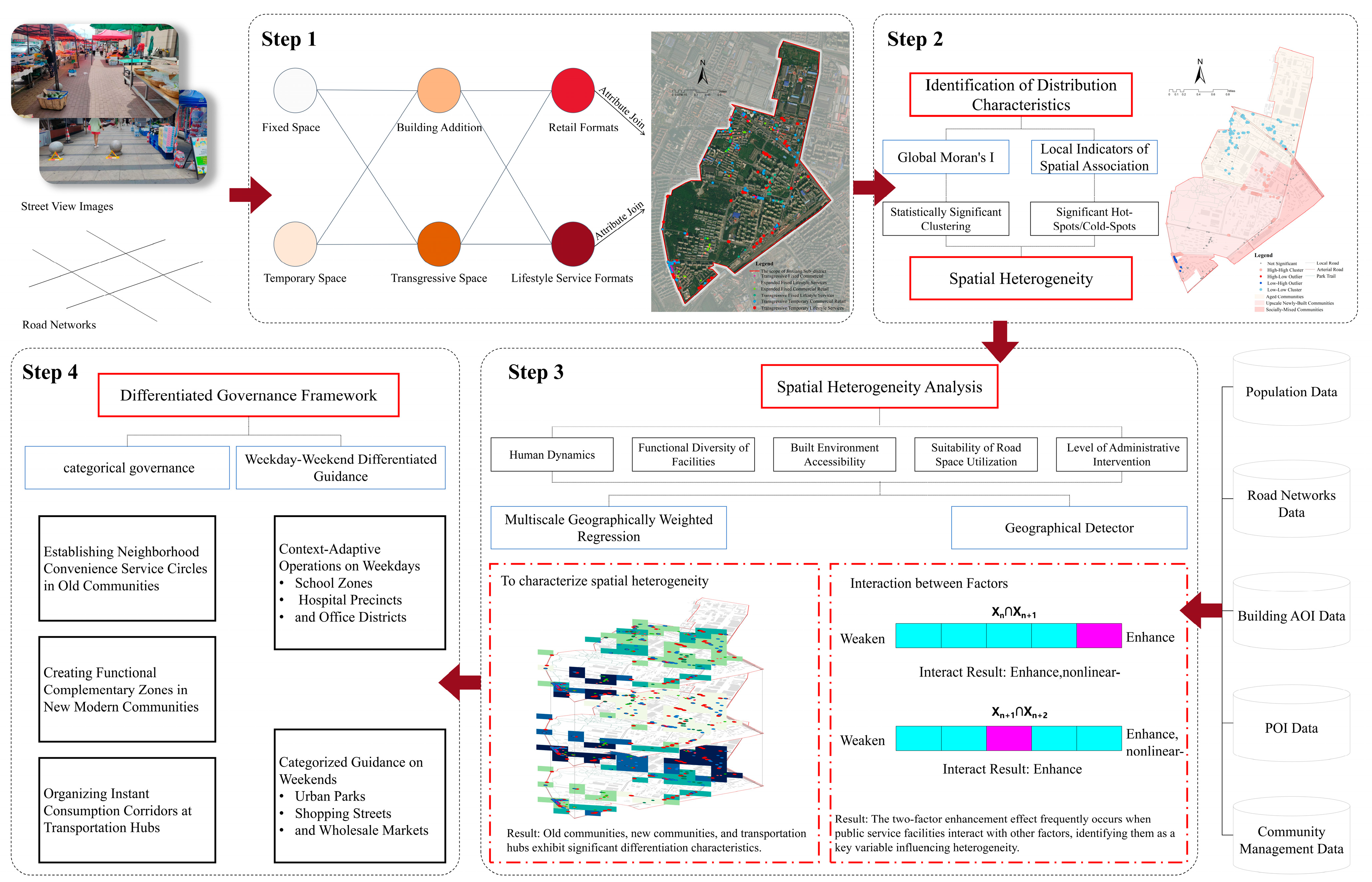
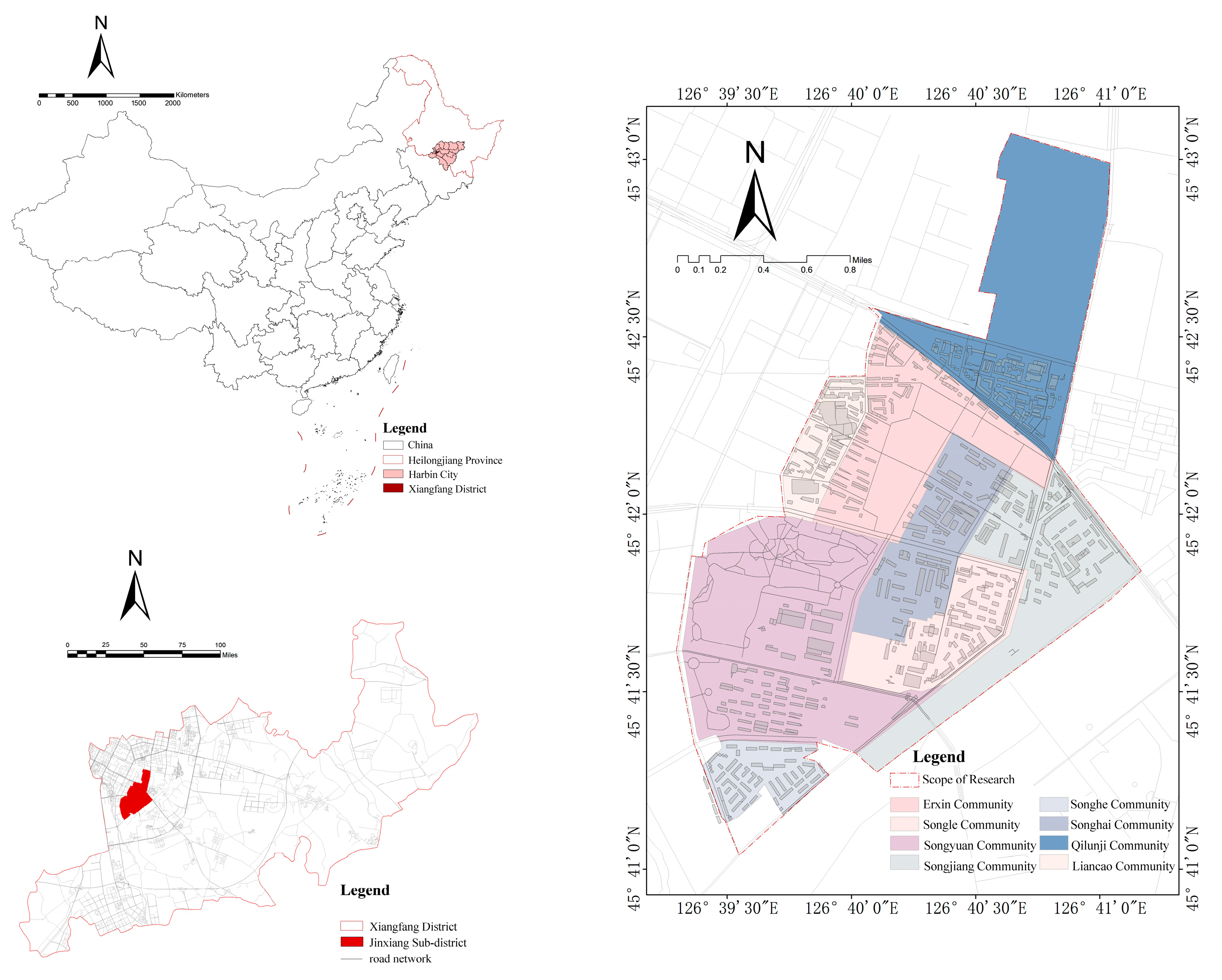

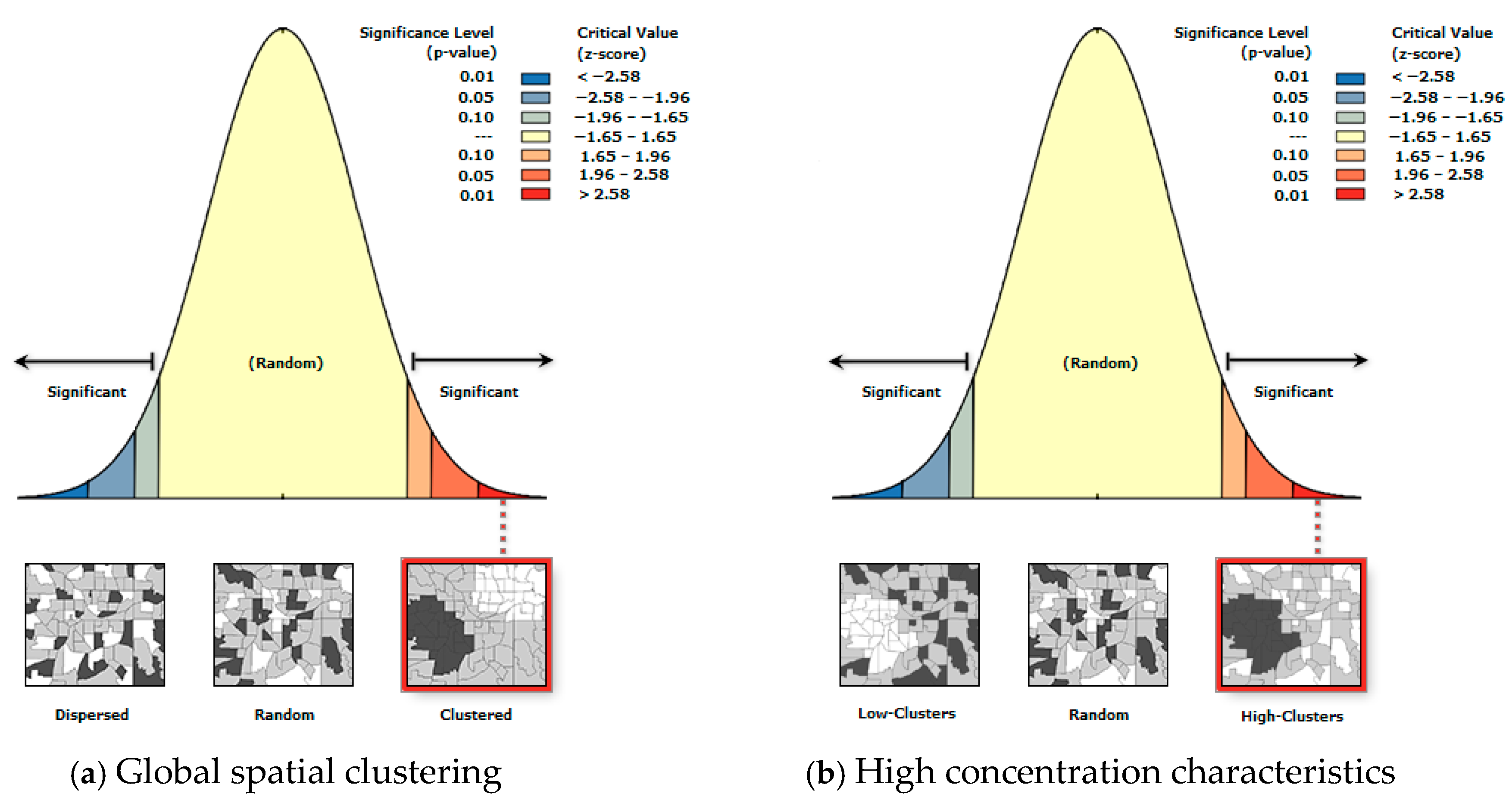








| Indicator Dimension | Integration with Right to the City Theory |
|---|---|
| population factors | Reflects market demand while embodying spatial users’ rights to assembly and demand diversity |
| functional diversity of facilities | Directly relates to equal access to urban services and spatial justice |
| accessibility of the built environment | Safeguards fundamental rights to access and utilize urban spatial resources across diverse groups |
| spatial suitability | Embodies the right of informal vendors to actively shape space through daily practices |
| intensity of community management | Directly manifests the interplay between urban managers’ “strategies” and informal vendors’ “tactics” |
| Evaluation Framework | Variable | Calculation Rules |
|---|---|---|
| population factors | Resident Population Density | The ratio of community population to community area |
| Weekday Pedestrian Activity Intensity | The study area’s location quotient of the population at one-hour intervals on weekdays/weekends reflects the population heat value during that time period. | |
| Weekend Pedestrian Activity Intensity | ||
| functional diversity of facilities | Facility Function Mix Index | Analyze the location quotient of major points of interest (POI) within the study area’s buffer zone to reflect the diversity of facilities. |
| Facility Function Density | Study the ratio of the total number of various categories of POI within the buffer area to the area range, reflecting the density distribution of facilities. | |
| Building Density | ||
| accessibility of the built environment | Residential Accessibility | Euclidean distance was employed to measure the actual distance between informal commerce locations and built environment facilities, reflecting their dependency on different built environment elements. All calculations were performed using the ArcGIS 10.8.1 (ESRI, Redlands, CA, USA). |
| Retail and Commerce Accessibility | ||
| Public Administration Accessibility | ||
| Public Service Accessibility | ||
| Transport Node Accessibility | ||
| Road Intersection Density | ||
| spatial suitability | Proximity to Arterial Roads | |
| Proximity to Local Streets | ||
| intensity of community management | Absence of Community Management | Euclidean distance measurement was utilized to calculate the actual distance between informal commercial locations and residential communities. This metric reflects the intensity of community management’s influence on the spatial distribution of informal commerce, with all computations completed in the ArcGIS 10.8.1 (ESRI, Redlands, CA, USA). |
| Basic-Level Community Management | ||
| Enhanced Community Management |
| Road Grade | Maximum Width (m) | Average Width (m) | Buffer (m) |
|---|---|---|---|
| Arterial Road | 40 | 40 | 55 |
| Local Street | 28 | 11.50 | 40 |
| Community Type | Neighborhood Name | General Profile |
|---|---|---|
| Aging Residential Communities | Qilunji Community | Built in an earlier period; the spatial layout is traditional and dispersed, with relatively unclear boundaries; governance is primarily resident-managed; buildings and supporting facilities are aging and have limited functionality. |
| Liancao Community | ||
| Erxin Community | ||
| Upscale Communities | Songle Community | The buildings are relatively new and highly modernized. The types of buildings are mainly high-rises and villas. Management and governance are professional. The supporting facilities are high-end and comprehensive, mostly exclusive amenities designed to enhance the quality of life. |
| Songhai Community | ||
| Songyuan Community | ||
| Socially Mixed Neighborhoods | Songhe Community | The construction spans a long period, blending old and new; professional management coexists with resident self-management; community spaces are well-organized and orderly, with clear boundaries. |
| Songjiang Community |
| Data Type | Data Attributes | Survey Period | Survey Cycle | Validation Method |
|---|---|---|---|---|
| Informal Commercial Space Locations | Latitude and Longitude, Business Type, Spatial Stability, Modification Degree, etc. | Morning (6:00–9:00), Noon (11:00–13:00), Evening (17:00–22:00) | Phase I: July–October 2024 (4 months); Phase II: July–October 2025 (4 months) | Cross-year Repeated Observation |
| Model Metrics | MGWR | GWR | OLS |
|---|---|---|---|
| Goodness-of-fit R2 | 0.936 | 0.759 | 0.775 |
| Adj. R2 | 0.919 | 0.752 | 0.768 |
| AICc | 346.813 | 820.295 | 13,606.693 |
| Residual sum of squares | 35.373 | 133.310 | — |
| Degree of freedom (n–trace(S)) | 437.543 | 459.509 | — |
| Bandwidths | 44–553 | 160 | — |
| Spatial kernel | Adaptive bisquare | Adaptive bisquare | — |
| Type | Definition | Count | Representative Imagery |
|---|---|---|---|
 Transgressive Fixed Commercial Retail | Commercial retail activities that permanently and fixedly occupy public spaces, breaching original planning boundaries. | 31 |  |
 Transgressive Fixed Lifestyle Services | Service-oriented businesses that permanently and fixedly occupy public spaces, breaching original planning boundaries. | 38 |  |
 Expanded Fixed Commercial Retail | Commercial retail operations involving physical expansion of existing structures, permanently occupying public space. | 36 | 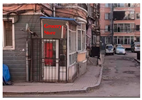 |
 Expanded Fixed Lifestyle Services | Service-oriented businesses involving physical expansion of existing structures, permanently occupying public space. | 36 |  |
 Transgressive Temporary Commercial Retail | Mobile retail activities utilizing movable facilities for short-term occupation of public spaces, violating planning boundaries. | 201 |  |
 Transgressive Temporary Lifestyle Services | Temporary informal spaces using simple facilities for short-term occupation, providing daily convenience services to residents. | 212 | 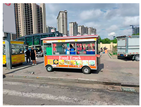 |
| Data Type | Data Content and Acquisition Method | Temporal Reference Used in Analysis | Data Source |
|---|---|---|---|
| Informal Commercial Locations | Comprehensive field survey recording spatial locations of informal commercial activities, resulting in an integrated geospatial dataset of 554 stable points. | Jul–Oct 2024 (supplemented by Jul–Oct 2025 data) | Research Team Field Survey |
| Population Density Data | Apply to the local government statistics bureau for census bulletin data at the street, town, and community levels. | 2020 (Seventh National Population Census) | Jinxiang Sub-district Office, Xiangfang District, Harbin City, Heilongjiang Province, China |
| Population Thermal Dynamics Data | Through Python programming, capture information such as user IDs, timestamp, and population density index. | Jul–Aug 2024 (synchronous with initial survey) | Baidu Smart Eye Platform (https://huiyan.baidu.com/, accessed on 5 June 2024) |
| Road Network Data | It mainly includes urban arterial roads, urban secondary roads, urban branch roads, and urban alleys within the study area. | June 2024 | OpenStreetMap (https://www.openstreetmap.org/, accessed on 5 June 2024) |
| Transport Node Data | Used POIKit 1.3.0 software to scrape the locations of bus and subway stations in the selected area. | June 2024 | Baidu Maps Open Platform (https://lbsyun.baidu.com/, accessed on 5 June 2024) |
| Building Footprint (AOI) Data | Use Python 3.9 to collect Baidu real estate data, including property ID, number of floors, and other information. | June 2024 | Baidu Maps Open Platform (https://lbsyun.baidu.com/) |
| Public Service Facility (POI) Data | Using POIKit 1.3.0 software to crawl POI data of 11 major categories in the selected area, such as shopping services, science and education culture, healthcare, and so on. | June 2024 | Baidu Maps Open Platform (https://lbsyun.baidu.com/) |
| COType | LMiIndex | LMiZScore | LMiPValue | Proportion of Samples (%) |
|---|---|---|---|---|
| HH | 0.004–2.524 | 1.706–7.060 | 0.002–0.050 | 39.3 |
| LL | 0.038–5.276 | 1.560–5.475 | 0.002–0.042 | 27.2 |
| No significant | 0.058–0.498 | −1.410–1.706 | 0.058–0.498 | 28.8 |
| Evaluation Framework | Variable X | Bandwidth | Mean | Standard Deviation | Minimum | Median | Maximum |
|---|---|---|---|---|---|---|---|
| population factors | Resident Population Density X1 | 100 | 0.050 | 0.122 | −0.546 | 0.057 | 0.290 |
| Weekday Pedestrian Activity Intensity X2 | 514 | 0.060 | 0.017 | 0.048 | 0.049 | 0.087 | |
| Weekend Pedestrian Activity Intensity X3 | 44 | 0.108 | 0.408 | −0.905 | −0.019 | 1.637 | |
| functional diversity of facilities | Facility Function Mix Index X4 | 128 | 0.031 | 0.207 | −0.725 | 0.009 | 0.352 |
| Facility Function Density X5 | 194 | 0.201 | 0.138 | −0.151 | 0.283 | 0.355 | |
| Building Density X6 | 553 | 0.001 | 0.009 | −0.013 | 0.007 | 0.016 | |
| accessibility of the built environment | Residential Accessibility X7 | 46 | −0.237 | 0.509 | −2.090 | −0.049 | 0.751 |
| Retail and Commerce Accessibility X8 | 123 | −0.543 | 0.886 | −2.194 | 0.006 | 0.126 | |
| Administration Accessibility X9 | 43 | 0.440 | 0.926 | −0.651 | −0.011 | 2.767 | |
| Public Service Accessibility X10 | 73 | −0.654 | 0.743 | −1.870 | −0.193 | 0.076 | |
| Transport Node Accessibility X11 | 64 | 0.269 | 0.635 | −0.268 | 0.073 | 2.949 | |
| Road Intersection Density X12 | 58 | 0.754 | 1.411 | −0.450 | −0.053 | 3.892 | |
| spatial suitability | Proximity to Arterial Roads X13 | 48 | 1.889 | 2.204 | −0.017 | 0.627 | 5.724 |
| Proximity to Local Road X14 | 123 | −0.364 | 0.708 | −1.613 | 0.057 | 0.145 | |
| intensity of community management | Absence of Community Management X15 | 50 | −0.821 | 1.431 | −3.412 | −0.058 | 0.450 |
| Enhanced Community Management X16 | 59 | 0.242 | 0.479 | −0.715 | −0.061 | 0.955 |
| Governance Dimension | Governance Context | Planning Tools | Regulatory Measures |
|---|---|---|---|
| Zoning Governance | Aging Residential Communities (Practice-Based Context) | 1. Establish neighborhood service zones using interstitial spaces for standardized stall areas 2. Integrate micro-renewal through public art and green infrastructure | 1. Community-based registration and co-management system 2. Vendor-maintained cleanliness through self-regulation |
| Upscale Communities (Capital-Guided Context) | 1. Designate flexible business zones at community entrances 2. Deploy modular container stalls with utility connections | 1. Flexible permitting with joint administration 2. Dynamic impact assessment and adjustment | |
| Transportation Hubs (Flow-Managed Context) | 1. Create timed commercial corridors within 50 m of exits 2. Separate vending areas from circulation paths | 1. Electronic monitoring of operating schedules 2. Real-time crowd monitoring and guidance | |
| Temporal Governance | Weekdays (Peak Adaptation) | 1. Position commute-oriented services near activity centers 2. Establish midday retail in commercial districts | 1. Time-specific operating permits 2. Restricted non-peak operations |
| Weekends (Leisure-Oriented) | 1. Develop curated markets in public spaces 2. Organize integrated service clusters | 1. Location-specific management strategies 2. Density adjustment using usage data | |
| Categorical Governance | All Spatial Contexts (Typological Approach) | 1. Business classification based on local needs 2. Standardized design and safety specifications | 1. Compliance-based credit system 2. Multi-level oversight mechanism |
| Driving Mechanism | Key Variables | Bandwidth | Mean Effect | Effect Intensity and Direction |
|---|---|---|---|---|
| Capital Logic (Harvey) | Transport Node Accessibility (X11) | 64 | +0.754 | Strong Positive Effect |
| Facility Function Density(X5) | 194 | +0.201 | Moderate Positive Effect, Spatially Heterogeneous | |
| Everyday Practice (Lefebvre) | Population Density (X1) | 100 | +0.050 | Weak Effect, Highly Heterogeneous |
| Proximity to Local Road (X14) | 123 | +0.057 | Positive Effect, Spatially Differentiated | |
| Building Density (X6) | 553 | +0.007 | Minimal Positive Effect | |
| Power Discipline (de Certeau) | Arterial Road Proximity (X13) | 48 | +0.627 | Strong Positive Effect (Avoidance Behavior) |
| Unregulated Management (X15) | 50 | −0.821 | Strong Negative Effect, Highly Heterogeneous | |
| Secondary Regulation (X16) | 59 | +0.242 | Weak Positive Effect, Highly Heterogeneous |
Disclaimer/Publisher’s Note: The statements, opinions and data contained in all publications are solely those of the individual author(s) and contributor(s) and not of MDPI and/or the editor(s). MDPI and/or the editor(s) disclaim responsibility for any injury to people or property resulting from any ideas, methods, instructions or products referred to in the content. |
© 2025 by the authors. Licensee MDPI, Basel, Switzerland. This article is an open access article distributed under the terms and conditions of the Creative Commons Attribution (CC BY) license (https://creativecommons.org/licenses/by/4.0/).
Share and Cite
Wu, H.; Pang, C. Heterogeneity of Influencing Factors for Informal Commercial Spaces in Communities from the Perspective of Right to the City: A Case Study of Harbin. Sustainability 2025, 17, 10462. https://doi.org/10.3390/su172310462
Wu H, Pang C. Heterogeneity of Influencing Factors for Informal Commercial Spaces in Communities from the Perspective of Right to the City: A Case Study of Harbin. Sustainability. 2025; 17(23):10462. https://doi.org/10.3390/su172310462
Chicago/Turabian StyleWu, Han, and Chunyu Pang. 2025. "Heterogeneity of Influencing Factors for Informal Commercial Spaces in Communities from the Perspective of Right to the City: A Case Study of Harbin" Sustainability 17, no. 23: 10462. https://doi.org/10.3390/su172310462
APA StyleWu, H., & Pang, C. (2025). Heterogeneity of Influencing Factors for Informal Commercial Spaces in Communities from the Perspective of Right to the City: A Case Study of Harbin. Sustainability, 17(23), 10462. https://doi.org/10.3390/su172310462





